Against the backdrop of the wide sky, Avy soared above the highest treetops, pirouetted midair and then, suddenly closing her wings, catapulted downwards to level off within a feather’s breath of the ground.
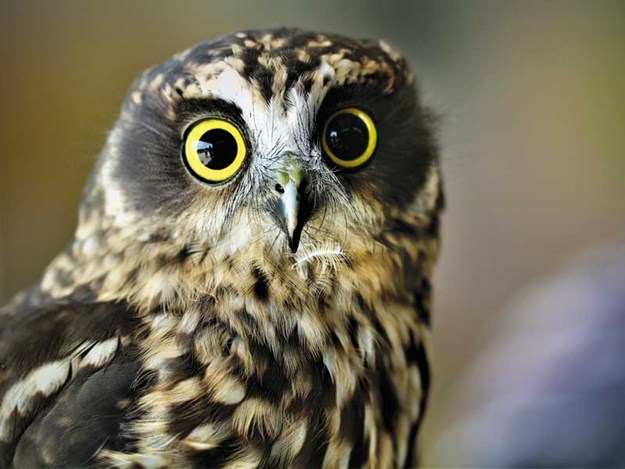 |
The heart-winning fledging morepork known as Cricket |
Even for a bird, it must take courage and precision to pull that off without a bungy cord. Watching her was exhilarating. If I didn’t know better, I might have thought the reason for her exuberant manoeuvres was the joy of flight, but I knew her eye was on the food at the end of the lure.
Avy is one of the karearea (New Zealand falcons) at the newly located Wingspan National Bird of Prey Centre in Rotorua.
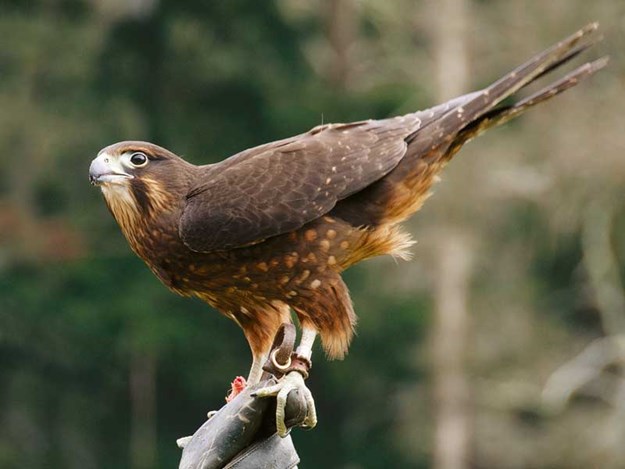 |
A karearea feeding on the gauntlet |
If it were not for the dedicated work carried out at this impressive facility, these unique birds, endemic to New Zealand, would be very close to extinction. They have been so victimised and undervalued that there are only an estimated 10,000 left in the wild, which is not a lot in survival terms. Tragically they are still being shot at the rate of 150 a year.
Over a year ago the well-known home of Wingspan took flight itself to move to a better locality on the northern slopes of Mount Ngongotaha. The new area is much larger and set among undulating hills with a view across to distant Lake Rotorua. The high ridges are rimmed by dense trees which beckon these raptors.
Karearea are forest falcons. Their wings are short and rounded, which give them manoeuvrability in dense woodlands; and they are formidable hunters, silently ambushing their prey with short bursts of incredible speed (up to 200km in a killer dive).
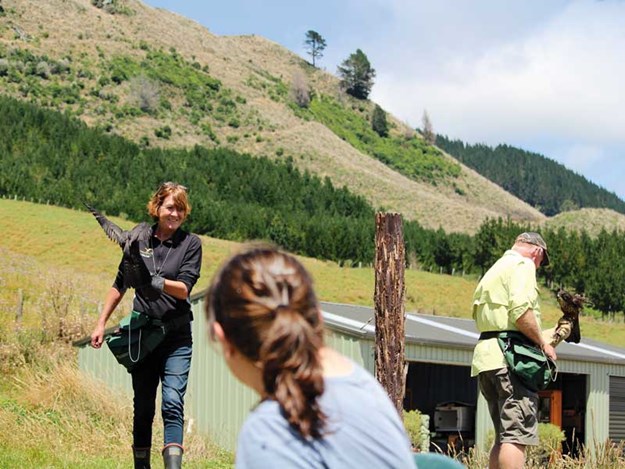 |
Avy’s star turn is finished and Debbie (left) brings out Shadow for the day’s training |
They are also known worldwide for their spectacular agility in flight. The new Wingspan is still undergoing development. It’s a registered charitable trust and relies on grants, sponsorships, and donations to turn the ambitious plans for the future centre into reality. It is happening, but it takes time.
Meanwhile, most of the feathered inhabitants – the falcons, harriers, and moreporks – are housed in satellite aviaries. But there was a great fluffing of feathers two months ago when the centre in Paradise Valley Road, near Ngongotaha, opened to the public for ‘progress’ visits. Limited numbers of spectators can book for one-hour visits.
I was among the lucky few and the small group of us who perched on temporary seating in the paddock were sheltered from the sun by large white umbrellas.
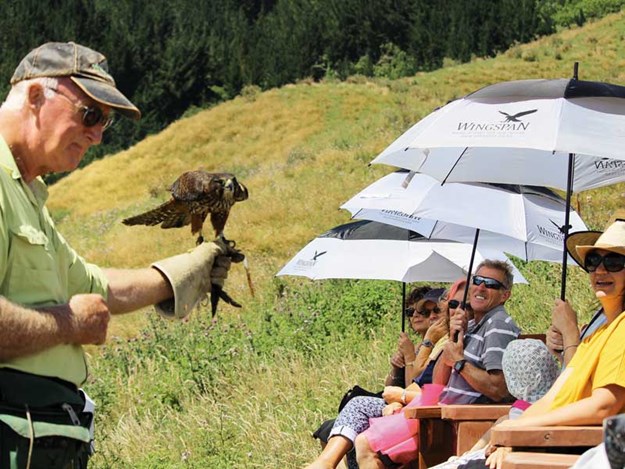 |
Noel Hyde, falconer for 40 years, introduces Avy at one of Wingspan’s progressive sessions |
Our spirits soared and dipped along with Avy’s amazing performance. The falcon was brought to the centre from Otago with an injury and is now building her strength for release back to the wild.
We also watched the antics of a troublesome little teenager in training called Shadow. “She a beautiful bird,” said the falconer, Debbie Stewart. “But she is strong-minded, and we are never quite sure what she is going to do next. Thankfully, if birds get lost, they are fitted with transmitters which makes it possible for us to locate them.”
Like all falcons, Shadow displayed a warrior attitude. She launched from her perch and seemed to slide though the air before landing precisely on the outstretched gauntlet of her trainer. With surprising gentleness for such murderous talons, she clamped herself in place, glared at the gathered audience and then began to tear at the morsel that had lured her – two small chicken legs that protruded from the side of the glove.
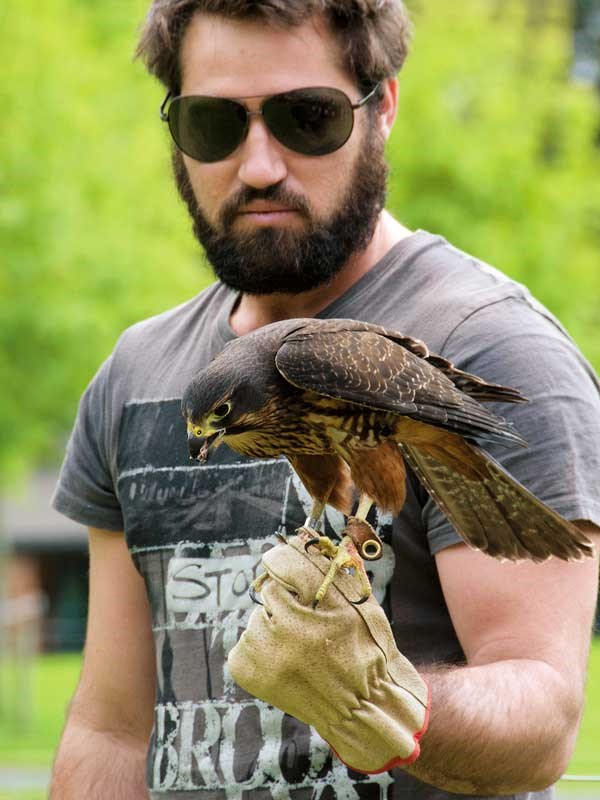 |
A spectator gets eye-to-eye with one of these intriguing birds of prey |
Debbie is the driving force behind Wingspan and has been awarded an NZ Order of Merit for her remarkable achievement for wildlife conservation. Years ago, she worked at Rotorua’s Rainbow Springs.
One day someone brought in an injured hawk, and, as she helped nurture it back to health, the experience fostered an admiration for birds of prey that she has never lost. Knowing their plight and determined to do something about it, she founded Wingspan, which has now been operating for 26 years.
In that time nearly 1000 birds have come under the company’s wings. Some are bred in captivity, some nurtured back to health after injury, and every bird that can be is released when their training is complete.
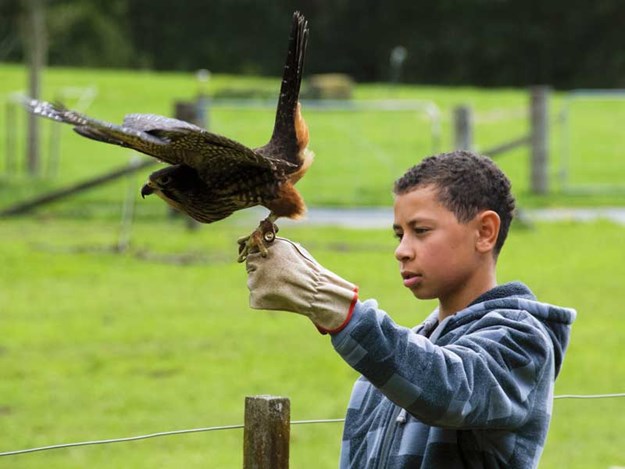 |
One of the 70,000 school children who have now had a close encounter with a karearea |
In a temporary shed at the new Wingspan, we learnt more about this conservation programme which has gained so many accolades from conservationists around the world.
“One other statistic I am really proud of,” says Debbie, “is that 70,000 children have now held a falcon on their hands. If they’ve looked one of these magnificent creatures in the eye, it’s unlikely they could ever wish them harm.”
The finishing touch on the experience was my close encounter with a cute little ruru (morepork) chick called Cricket, who was bred at the centre and has just begun to fly. If I wasn’t already a committed raptor devotee, this round-eyed little chap would have certainly swung the deal.
Win a one-hour progress viewing at Wingspan’s new site
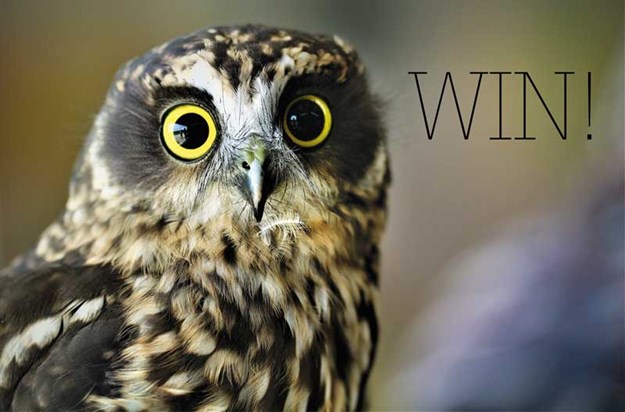
Wingspan has kindly invited two lucky readers to join a select group to attend a free, one-hour progress viewing at Wingspan’s new site.
Enter here before 8 March, 2019 to be in to win.





